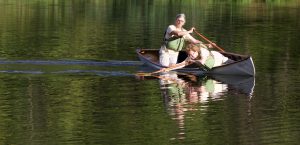By Bruce Kemp, first published in March 2016
Speaking as one who still feels relatively new to the performance end of FreeStyle, and still has lots to learn, here’s some things I think I think about tandem FreeStyle. So far, anyway. These remarks are directed towards “newer” tandem FreeStylers, or those who might be thinking of giving Tandem FreeStyle a try. One way, among many, to think about it…
I have two “mantras”, if you will, about tandem paddling – whether that be in a FreeStyle Interpretive routine, or in everyday paddling down some river somewhere. They are – “the Bow Paddler is Running the Show”, and “the Stern follows the Bow”. While here I am talking primarily about Interpretive FreeStyle, or paddling a “routine” to music, it all applies just as much to tandem paddling in any situation…
From the very first lessons that Anita and I took together, it was quickly and abundantly clear how very dominant the bow paddler (Anita, in our case) is in “running the show”, as I often put it. One of my very early, sort of off-hand/short-hand attempts to speak of the stern’s role in forward moves went something like “I just try to do whatever I think I need to do, or can do, to help the stern follow the arc that the bow’s describing”. A bit simplistic of course, but there’s a lot of truth to it. As we progress in our ongoing learning, I try to get better at doing that in my technique and efficiency, and add what I can to that arcing with my initiations, placements, and conclusions; try also to maybe add a bit of grace or style to it. But the basic point remains – the Stern follows the Bow.
“Follows” in just about every way. In some ways, for the person running the show, as I say, a bow paddler is working at some disadvantage relative to the stern paddler, at least in Interpretive FreeStyle. Anita can’t really see very much, in a certain sense, from where she sits – a couple feet of boat, and a whole lot of water, is about it. She (usually) can’t see me back there, and to a degree doesn’t really know what’s going on behind her. From the stern, I can see lots of things that are really helpful – I see the whole length of the boat (it’s easier to judge sideslips, for instance – like sighting down a rifle as Tryon Lindabury likes to say – or see if we’re moving straight in a stroking sequence); I can see how close the rail is to the water during a maneuver; I can more easily see where we are in the arcing, and where 180̊ (or 225, or 270…) is; and of course I see every move she makes. These are all useful things for a stern paddler, any tandem paddler, but Anita, in the bow, can’t much make use of them…
Much of tandem paddling is being in sync with each other. Since Anita can’t see me behind her, it is up to me in the stern to try to match/mirror her moves as much as I can – paddle to her cadence; catch the water when she does; recover when and how she does; match my shaft angle to hers; co-ordinate my initiations/conclusions with hers; try to match her degree of “oomph” in those strokes where that matters. ‘Most everything is keyed off what the bow paddler is doing; it’s all synced to Anita. The stern’s following the bow.
